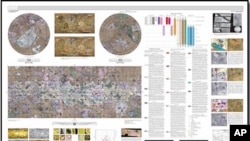U.S astronomers have created the first complete geologic map of Jupiter’s highly volcanic moon, Io.
With 425 volcanoes dotting its surface, Io is more than 25 times more volcanically active than the Earth, yet this innermost of Jupiter's larger satellites is only slightly bigger than our Moon.
Io's varied surface features include mountains, volcanic domes, plains, and lava lakes. The Arizona State University astronomers say the new full-color map shows the location and concentration of the most active hot spots and lava fields on the surface - information that will help scientists better understand the moon's interior processes.
Astronomers believe Io's extreme volcanic activity is caused by the powerful tidal forces exerted by Jupiter - the solar system's most massive planet - and two of its 62 other confirmed moons, Europa and Ganymede. Their combined gravitational pull stretches and bends Io’s rocky crust, generating tremendous heat in the interior that is released through hundreds of volcanoes. The extreme seismic activity continuously changes the moon's surface, which explains why Io is the only rocky object in the solar system without any impact craters.
Six years in the making, the new map is a composite of four separate image mosaics comprised of observations made by NASA's twin Voyager spacecraft and the Jupiter orbiter, Galileo.
But the astronomers say they are not done yet.
Later this year, they plan to complete an on-line database that will include the geologic map of Io, plus the original image mosaics, and other Galileo spacecraft observations. The researchers say the database will allow users to track the history of surface changes on Io caused by volcanic activity.
The map of Io is published on the U.S. Geological Survey website.
The 17th century Italian astronomer, Galileo, discovered Io and three other moons of Jupiter in 1610. Now known as the Galilean moons, the four lunar siblings are: Io, Callisto, Ganymede, and Europa.
News
New Geologic Map Reveals Solar System's Most Volcanic World







